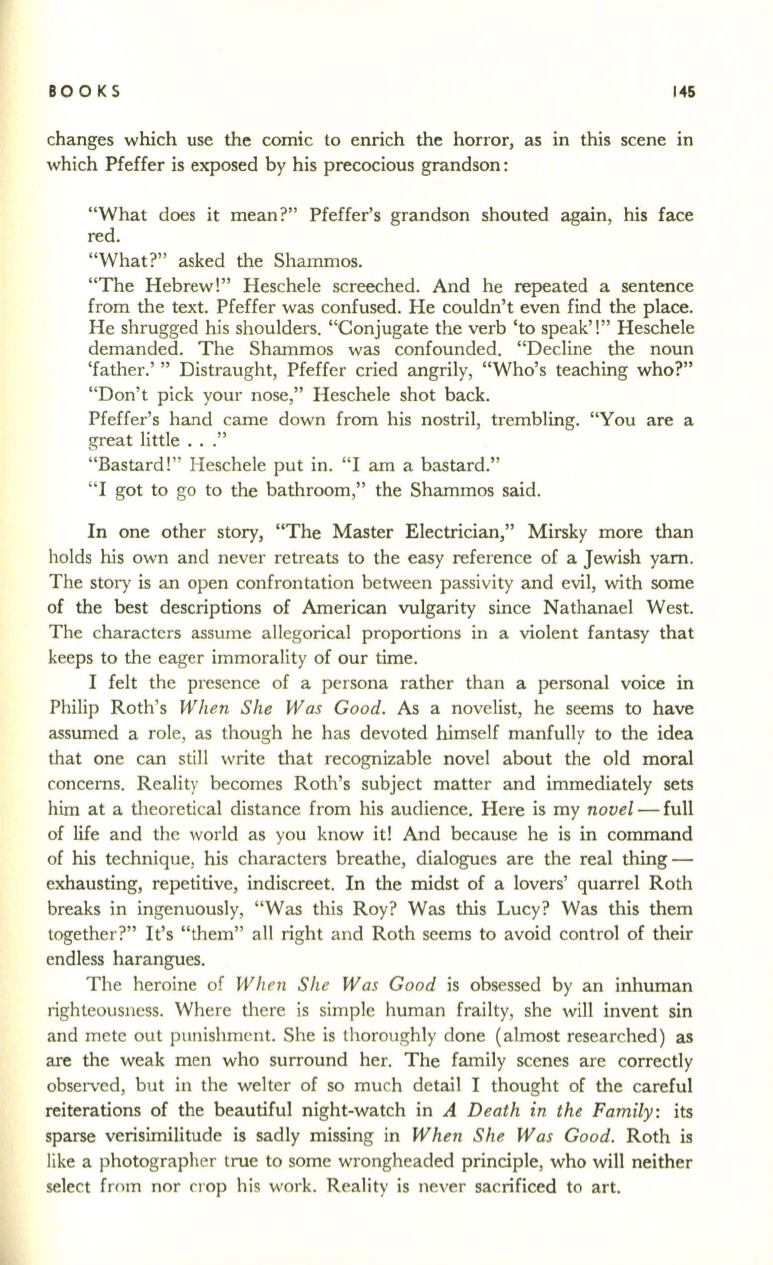
BOO KS
145
changes which use the comic to enrich the horror, as m this scene m
which Pfeffer is exposed by his precocious grandson:
"What does it mean?" Pfeffer's grandson shouted again, his face
red.
"What?" asked the Shammos.
"The Hebrew!" Heschele screeched. And he repeated a sentence
from the text. Pfeffer was confused. He couldn't even find the place.
He shrugged his shoulders. "Conjugate the verb 'to speak'!" Heschele
demanded. The Shammos was confounded. "Decline the noun
'father.''' Distraught, Pfeffer cried angrily, "Who's teaching who?"
"Don't pick your nose," H eschele shot back.
Pfeffer's hand came down from his nostril, trembling. "You are a
great little .. ."
"Bastard!" Heschele put in. "I am a bastard."
"I got to go to the bathroom," the Shammos said.
In one other story, "The Master Electrician," Mirsky more than
holds his own and never retreats to the easy reference of a Jewish yarn.
The story is an open confrontation between passivity and evil, with some
of the best descriptions of American vulgarity since Nathanael West.
The characters assume allegorical proportions in a violent fantasy that
keeps to the eager immorality of our time.
I felt the presence of a persona rather than a personal voice in
Philip Roth's
When She Was Good.
As a novelist, he seems to have
assumed a role, as though he has devoted himself manfully to the idea
that one can still write that recognizable novel about the old moral
concerns. Reality becomes Roth's subject matter and immediately sets
him at a theoretical distance from his audience. Here is my
novel-
full
of life and the world as you know it! And because he is in command
of his technique, his characters breathe, dialogues are the real thing–
exhausting, repetitive, indiscreet. In the midst of a lovers' quarrel Roth
breaks in ingenuously, "Was this Roy? Was this Lucy? Was this them
together?" It's "them" all right and Roth seems to avoid control of their
endless harangues.
The heroine of
When She W as Good
is obsessed by an inhuman
righteousness. Where there is simple human frailty, she will invent sin
and mete out punishment. She is thoroughly done (almost researched) as
are the weak men who surround her. The family scenes are correctly
observed, but in the welter of so much detail I thought of the careful
reiterations of the beautiful night-watch in
A Death in the Family:
its
sparse verisimilitude is sadly missing in
When She Was Good.
Roth is
like a photographer true to some wrongheaded principle, who will neither
select from nor crop hi s work. Reality is never sacrificed to art.


